The Sandy Bridge Pentium Review: G850, G840, G620 & G620T Tested
by Anand Lal Shimpi on August 23, 2011 12:11 AM ESTThe Test
As always we're only presenting a subset of our entire CPU test suite here. For all of the numbers as well as other comparison options check out Bench.
| CPU: |
AMD A8-3850, AMD A6-3650, AMD Athlon II X4 635, AMD Athlon II X3 455, AMD Athlon II X2 265 Intel Core i3-2100, Intel Core i3 540, Intel Pentium G850, Intel Pentium G840, Intel Pentium G620, Intel Pentium G620T |
| Motherboard: |
Intel DH67BL (Intel H67) ASRock A75 Extreme6 (AMD A75) |
| Chipset Drivers: |
Intel 9.2.0.1025 AMD Catalyst 8.862 RC1 |
| Hard Disk: | Intel X25-M (80GB), Corsair P256 SSD (256GB) |
| Memory: | G.Skill DDR3-1866 2 x 4GB |
| Video Drivers: |
AMD Catalyst 8.862 RC1 Intel 2372 |
| Desktop Resolution: | 1920 x 1200 |
| OS: | Windows 7 x64 |
Adobe Photoshop CS4 Performance
To measure performance under Photoshop CS4 we turn to the Retouch Artists’ Speed Test. The test does basic photo editing; there are a couple of color space conversions, many layer creations, color curve adjustment, image and canvas size adjustment, unsharp mask, and finally a gaussian blur performed on the entire image.
The whole process is timed and thanks to the use of Intel's X25-M SSD as our test bed hard drive, performance is far more predictable than back when we used to test on mechanical disks.
Time is reported in seconds and the lower numbers mean better performance. The test is multithreaded and can hit all four cores in a quad-core machine.

The Pentium G620 does a lot better than its Athlon II X2 counterpart, there's no contest here. The race is a lot closer between the G840/850 and the Athlon II X3 455, but in the end the Pentiums are faster. Both perform a bit better than the more expensive AMD A8-3850.
x264 HD Video Encoding Performance
Graysky's x264 HD test uses the publicly available x264 encoder to transcode a 4Mbps 720p MPEG-2 source. The focus here is on quality rather than speed, thus the benchmark uses a 2-pass encode and reports the average frame rate in each pass.
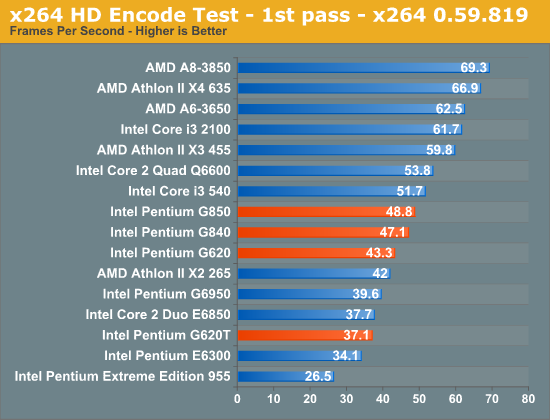

Once again the G620 is faster than the Athlon II X2 265 despite the latter's clock speed advantage. The G840 and G850 are faster than the 620 but not fast enough to overcome the extra core advantage of the X3 455. If you're spending $80 on a CPU for video encoding go for the Athlon II X3 455.
3dsmax 9 - SPECapc 3dsmax CPU Rendering Test
Today's desktop processors are more than fast enough to do professional level 3D rendering at home. To look at performance under 3dsmax we ran the SPECapc 3dsmax 8 benchmark (only the CPU rendering tests) under 3dsmax 9 SP1. The results reported are the rendering composite scores:

Not all heavily threaded tasks are going to favor more cores. In this case the IPC advantages of Sandy Bridge give the G850 equal performance to the X3 455.
Cinebench R10
Created by the Cinema 4D folks we have Cinebench, a popular 3D rendering benchmark that gives us both single and multi-threaded 3D rendering results.
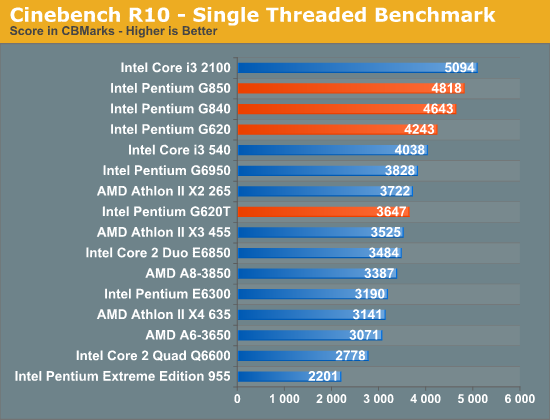
Single threaded performance is going to be a big advantage of the SNB Pentiums. Even the G620 is a good 14% faster than AMD's Athlon II X2 265 and the rest scale up with clock speed. What this translates to is great general use performance as well as solid performance in those apps that are still bound by the performance of a single thread.
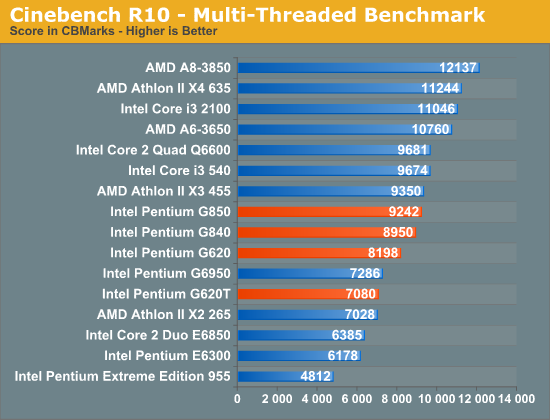
Multithreaded apps however start to benefit from more cores. In this case the Athlon II X3 455 isn't much faster than a G850 and only 4.5% faster than a G840, despite its core count advantage.
PAR2 Multithreaded Archive Recovery Performance
Par2 is an application used for reconstructing downloaded archives. It can generate parity data from a given archive and later use it to recover the archive
Chuchusoft took the source code of par2cmdline 0.4 and parallelized it using Intel’s Threading Building Blocks 2.1. The result is a version of par2cmdline that can spawn multiple threads to repair par2 archives. For this test we took a 708MB archive, corrupted nearly 60MB of it, and used the multithreaded par2cmdline to recover it. The scores reported are the repair and recover time in seconds.
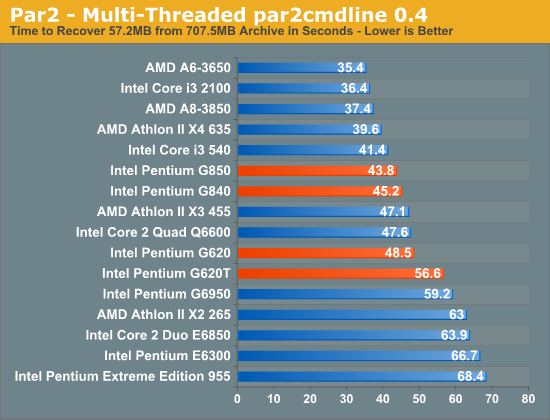
Our Par2 extraction test is another multithreaded scenario where two Sandy Bridge cores manage to slightly outperform three Athlon II cores. Whereas before it was a pretty simple "more cores, better multithreaded performance" argument, the SNB Pentiums do complicate things a bit.
WinRAR - Archive Creation
Our WinRAR test simply takes 300MB of files and compresses them into a single RAR archive using the application's default settings. We're not doing anything exotic here, just looking at the impact of CPU performance on creating an archive:
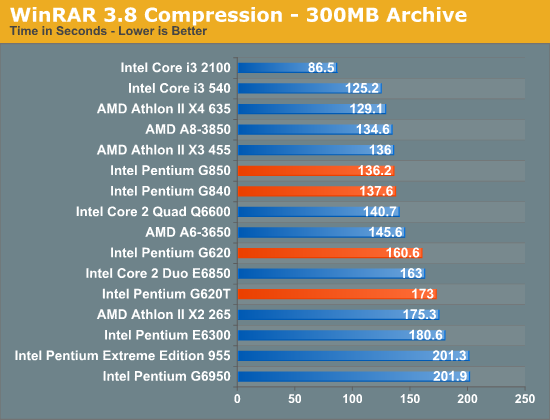
Once again we've got a multithreaded test with a murky outcome. The G850 is hot on the heels of the Athlon II X3 455, as is the G840.
Gaming Performance
Our first set of gaming performance results come using a discrete GPU. In the case of the Crysis Warhead results it's a GeForce GTX 280, while everything else uses a Radeon HD 5870. Across the board the Pentium manages to do better than its Athlon II competitors, of course with a discrete GPU that's not unexpected. Next we'll see how these stack up with processor graphics.
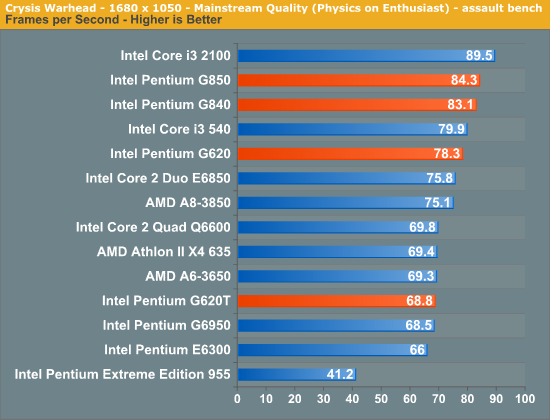
Dragon Age Origins is another very well received game. The 3rd person RPG gives our CPUs a different sort of workload to enjoy:
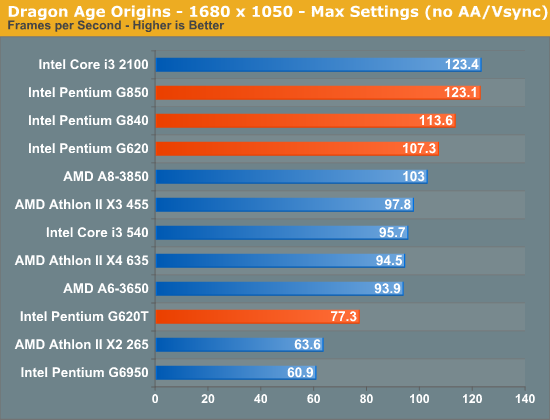
World of Warcraft needs no introduction. An absurd number of people play it, so we're here to benchmark it. Our test favors repeatability over real world frame rates, so our results here will be higher than in the real world with lots of server load. But what our results will tell you is what the best CPU is to get for playing WoW:
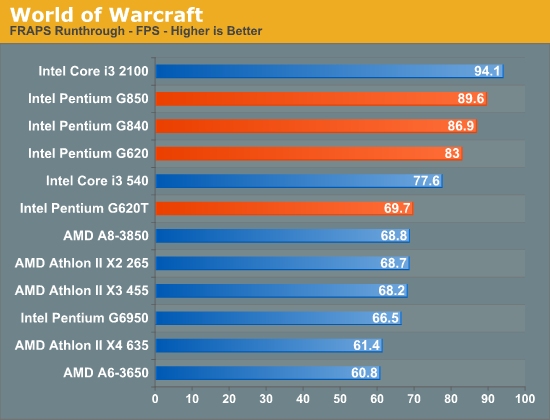

Power Consumption
The new Pentiums draw very little power, not only compared to their AMD counterparts but also the rest of the Sandy Bridge lineup.Without Hyper Threading, overall execution resource utilization is lower and thus power consumption is lower. It doesn't look like any of these chips come close to hitting their max TDPs as the Pentium G620T only draws 4W less than the G620 despite being rated with a 30W lower TDP.
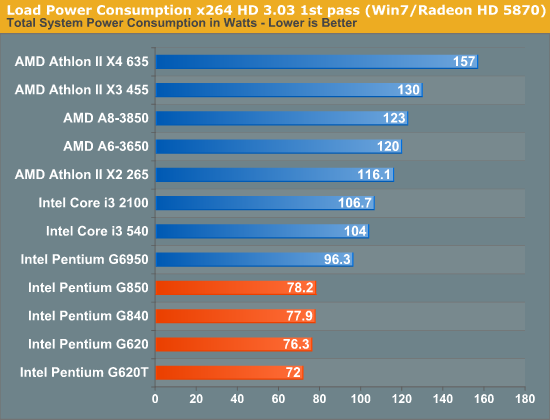










110 Comments
View All Comments
loeakaodas - Tuesday, August 23, 2011 - link
Why intel, why? Do you still ram these chips down our throats, they're so short of features that would be great for a cheap HTPC, but aren't all that attractive if you want to do anything but basic stuff with your machine.Blaze-Senpai - Tuesday, August 23, 2011 - link
And this is aimed at those people that only want to do basic stuff with their machine.yankeeDDL - Tuesday, August 23, 2011 - link
It still makes no sense: a Pentium 850 costs $98 (http://www.newegg.com/Product/Product.aspx?Item=N8... an A6-3650 costs $119 (http://www.newegg.com/Product/Product.aspx?Item=N8...For $20 you get a real graphic cards which acelerated web browsing and video decoding, so it is actually very useful even for very basic systems.
I see no value, whatsoever, for entry-level Sandy Bridge, as they have a higher price/performance ratio than most AMD stuff.
Incidentally, while SB is undoubtedly the finest piece of CPU technology today, at these prices it makes sense only starting from the Core i5-2400, which, basically, outperforms nearly every AMD CPU.
ET - Tuesday, August 23, 2011 - link
A G620 plus a discrete low mid range ($70-80) GPU will give you a much better entry level gaming PC than an A6-3650, for not a lot more money. (For about the same price as an A8-3850, which will still be slower for gaming than the G620 system).yankeeDDL - Tuesday, August 23, 2011 - link
I am not convinced, but you might be right about the gaming rigs. I would argue that a cheap discrete graphic card would CrossFire nicely with tha A6, but that's not the point anyway.I was talking, however, about entry-level systems.
There`s a "Best CPU for the money" update on Tom's hardware today: you can see that the G620 is not even in the picture, in favor of the Athlon II X3 and the G850.
If I was to play games rarely, I would much rather have an efficient but relatively powerful APU, than having to use an external graphic card: this way I wouldn't have to pay the electricity bill to have my GPU run a screensaver.
Taft12 - Tuesday, August 23, 2011 - link
Perhaps, but an Athlon II X3 450 plus the same $70-80 GPU would make for an even better entry level gaming PC at the same price.lowlymarine - Tuesday, August 23, 2011 - link
Not really. Many games still struggle to hit even two cores efficiently; few if any would benefit significantly from the third.Roland00Address - Tuesday, August 23, 2011 - link
For example see Grand Theft Auto IV PC edition. This game is unplayable on a Dual Core pc without a massive overclock, but runs fine on a slow tri or quad core. This was due to Xbox 360 having a tri-core processor (The 360 cpu is also a PowerPC design not x86 but that doesn't really matter.)Samus - Tuesday, August 23, 2011 - link
great article Anand!owned66 - Sunday, February 10, 2013 - link
most games after 2011play very well with multicore systems
my qx6700 was maxed out at 100% playing bf3
playing with a 2600 sandy maxes out at 85% equally on all cores and gpu maxed at 100% gpu load
increasing gpu clocks would increase cpu load which is a good sign of fine tuning